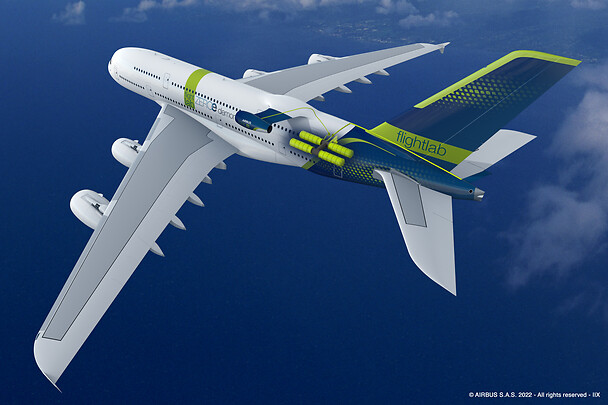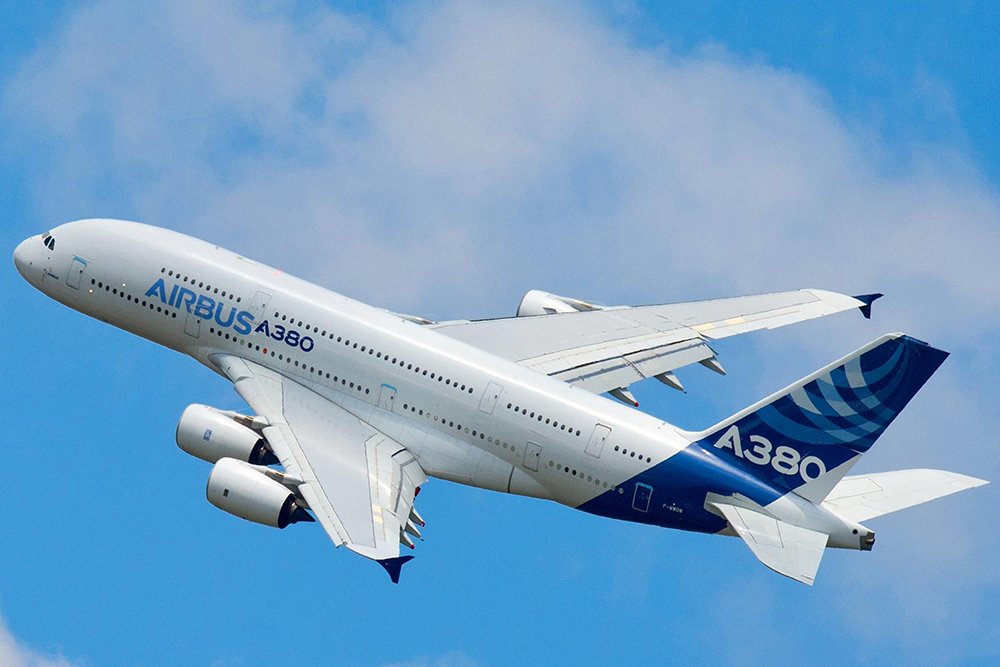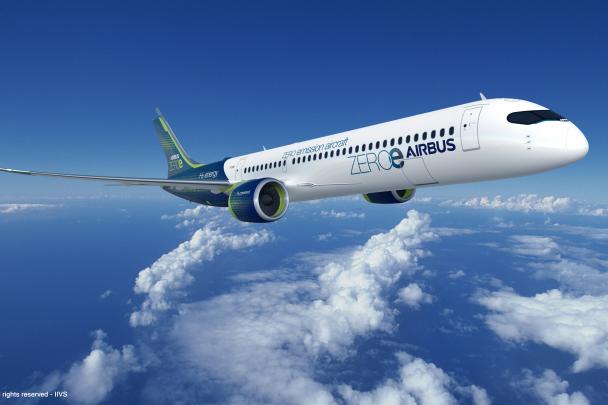Airbus aims to use a modified A380 provided with hydrogen fuel tanks as a test platform. Airbus declared Tuesday it will partner with GE Aviation and CFM International to “flight test a direct combustion engine fueled by hydrogen in preparation for entry into service of a zero-emission aircraft by 2035.”
Airbus Americas chairman and CEO Jeff Knittel told

Airbus Americas chairman and CEO Jeff Knittel told the flight test aircraft will be a modified Airbus A380—currently the world’s biggest passenger airliner—equipped with four liquid hydrogen tanks that will fuel a GE Passport turbofan engine located along the rear fuselage of the plane.
The overall flight test plan is still being determined, Airbus told, but current plans call for the first flight of the demonstrator by the end of 2026. Final technology choices should be made by the end of the decade, the company expressed, in time for a new zero-emissions aircraft to enter the market by the 2035 goal.
Tuesday’s statement is the latest growth in Airbus’ initiative aimed at exploring the potential of hydrogen as an alternative fuel in hopes of pushing the aviation industry closer to net-zero carbon emissions. It’s part of a larger movement across all aviation sectors being driven by the threat of international climate change.
American and European
Along with Airbus, the hydrogen demonstrator partnership includes CFM International, which is jointly owned by GE Aviation and Safran Aircraft Engines.
“By leveraging the expertise of American and European engine manufacturers to make progress on hydrogen combustion technology, this international partnership sends a clear message that our industry is committed to making the zero-emission flight a reality,” said Airbus chief technical officer Sabine Klauke.
The A380’s liquid hydrogen tanks will be set at Airbus facilities in France and Germany. Airbus will define the hydrogen propulsion system requirements, oversee flight testing, and provide the actual A380 platform to test the hydrogen combustion engine in the cruise phase.
Also, read
- FAA tightens up approval for Boeing 787 Dreamliners to check manufacturing
- AirCar Certified to Fly! – CAA issues Certificate of Airworthiness
- Is Mexico city’s new airport going to succeed?
For its part, CFM International will modify the combustor, fuel system, and control system of the GE Passport turbofan to run on hydrogen.
Airbus told the engine, which is assembled in the United States, was selected for this schedule because of its physical size, developed turbomachinery, and fuel flow capacity. Plans call for it to be mounted along the rear fuselage of the A380 so engine emissions, including contrails, can be monitored separately, apart from the conventional engines powering the testbed.
- CFM is hoping to execute an extensive ground test schedule ahead of the A380 flight test. “Hydrogen combustion capacity is one of the foundational technologies we are developing and maturing as part of the CFM RISE Program,” told Gaël Méheust, president and CEO of CFM. “Bringing together the collective capabilities and experience of CFM, our parent companies, and Airbus, we do have the dream team in place to successfully demonstrate a hydrogen propulsion system.”

The news of Airbus’ decision to move forward with its zero-emissions project comes as no surprise. It has been hinting at such plans for months. News surfaced late last year that Airbus was planning to test fly an existing CFM International engine converted for hydrogen propulsion. When FLYING asked Airbus to verify those statements, the company did not renounce them and would only say they often perform developmental engine testing with powerplant manufacturers.
- The announcement comes nearly 18 months after Airbus unveiled its so-called ZEROe hydrogen concept airliner designs: a turbofan, a turboprop, and a blended-wing body.
Airbus has also been cooperating for months with hydrogen producers and publicly expressing confidence about the fuel’s viability.
During an online event Tuesday unveiling the statement, Airbus offered a video tour of the specific aircraft that will be used as the testbed. The A380 that will eventually be developed into the testbed will be MSN 1, Airbus’s first-built A380, which served for certification and testing during the birth of the A380 program. MSN 1 also served as a testbed for engines operated in Airbus’s A350 program.
On the flight deck of the demonstrator, pilots will be managing power to the hydrogen engine with a separate throttle, Airbus said. They also will have a display that specifically monitors the main KPIs for the entire system. Data will be fed via telemetry in real-time to engineers on the ground for analysis.
The issue driving all of this is carbon emissions. Civil aviation creates about 2 percent of all carbon emissions, worldwide. Many of the world’s largest airlines have already committed to reducing their fleets to net-zero emissions by 2050, if not sooner, including Air France, American Airlines, British Airways, Delta Air Lines, Lufthansa, Southwest, and others.
United Airlines and Alaska Air Group
United Airlines and Alaska Air Group have already invested significantly in the research and development of hydrogen-powered aircraft.
During hydrogen aviation, fuel webinar in October 2021, Airbus vice president of zero-emission aircraft Glenn Llewellyn offered additional hints of Tuesday’s announcement. Of Airbus’ three ZEROe concepts, he told the blended-wing body was less likely to be developed.
“It’s much more likely that we would have a turbofan or turboprop—a more classical tube and weight configuration in terms of aircraft concept—nonetheless with a disruptively different propulsion system,” Llewellyn said.
Types of Hydrogen Power Systems

Engineers have been considering multiple ways to use hydrogen fuel to power airplanes, including hydrogen fuel cells, hydrogen gas turbines that burn hydrogen, and hybrid combinations, Llewellyn said.
Hydrogen gas turbines power engines with internal combustion, equal to traditional combustion engines that burn jet-A. Unlike traditional combustion engines, hydrogen burns cleanly.
Hydrogen Design Hurdles
Hydrogen-powered aircraft require fuel tanks large enough to carry the quantity of liquid hydrogen required for standard short- and medium-haul routes. Hydrogen packs more energy by weight than jet fuel, but it has lower energy by density. At room temperature hydrogen is a gas, making it hard to store in large quantities.
There’s an additional factor. Storing it in fuel tanks aboard aircraft requires hydrogen to be compressed into liquid form. To do that, hydrogen must be cooled to extremely low temperatures. In addition to the fuel and fuel tanks, the equipment needed to keep hydrogen fuel at low temperatures would add even more weight to a hydrogen-fueled aircraft. And because any counted weight on an aircraft is a disadvantage, it’s always a key factor in any design.

To deal with the challenges presented by hydrogen fuel, Airbus told Tuesday it intends to develop a new cryogenic fuel delivery system to move hydrogen from the tanks to the turbofan engine. First, hydrogen needs to be converted from liquid to gas. Next, the hydrogen gas will be injected into the fuel combustor and then ignited at a very high temperature—much hotter than
Newly developed components will be required to withstand those high temperatures, the company told.
Developing the ecosystem and surrounding infrastructure to support wide-scale use of liquid hydrogen as aviation fuel is a gigantic hurdle that experts point to as key to success. Production, storage, and delivery would all have to be scaled up. To transform the entire hydrogen fuel ecosystem to completely “green” would make this plan even more difficult.
This isn’t the first push to make a hydrogen-fueled airliner. In the late 1980s, Soviet engineers developed the experimental Tupolev Tu-155, which completed about 100 test flights before the program was revoked during the collapse of the Soviet Union.
Sustainable aviation is the future and hydrogen
“Sustainable aviation is the future and hydrogen is an important step in that process, and maybe the ultimate step,” Knittel told Tuesday.
Méheust acknowledged there’s a lot of work to be done. “But it doesn’t seem to be insurmountable…we see the technological path to achieve that. And with effort and hard work we should be capable to make it.”

Yes, the goals are very challenging, told GE Aviation vice president Mohamed Ali. “But that’s what we’re all about. And we’re not doing them just because they are hard…we’re doing them because we think we can invent the future of flight. And it’s secure. And it’s affordable.
Thank you
Stay updated with Aviationa2z.com
